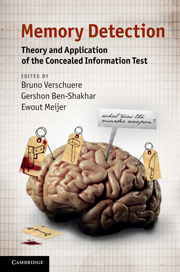Book contents
- Frontmatter
- Contents
- List of figures
- List of tables
- Notes on contributors
- Acknowledgments
- Part I Introduction
- Part II The laboratory: theoretical and empirical foundations of the Concealed Information Test
- Part III Field applications of concealed information detection: promises and perils
- 8 Limitations of the Concealed Information Test in criminal cases
- 9 Validity of the Concealed Information Test in realistic contexts
- 10 Leakage of information to innocent suspects
- 11 Countermeasures
- 12 Psychopathy and the detection of concealed information
- 13 Clinical applications of the Concealed Information Test
- 14 Daily application of the Concealed Information Test: Japan
- 15 The Concealed Information Test in the courtroom: legal aspects
- Part IV Conclusions
- Index
- References
13 - Clinical applications of the Concealed Information Test
Published online by Cambridge University Press: 05 June 2012
- Frontmatter
- Contents
- List of figures
- List of tables
- Notes on contributors
- Acknowledgments
- Part I Introduction
- Part II The laboratory: theoretical and empirical foundations of the Concealed Information Test
- Part III Field applications of concealed information detection: promises and perils
- 8 Limitations of the Concealed Information Test in criminal cases
- 9 Validity of the Concealed Information Test in realistic contexts
- 10 Leakage of information to innocent suspects
- 11 Countermeasures
- 12 Psychopathy and the detection of concealed information
- 13 Clinical applications of the Concealed Information Test
- 14 Daily application of the Concealed Information Test: Japan
- 15 The Concealed Information Test in the courtroom: legal aspects
- Part IV Conclusions
- Index
- References
Summary
Overview: The Concealed Information Test (CIT) can prove useful in assessing clinical populations where individuals are unable or unwilling to report on their mnemonic experience. Unlike the traditional use of the CIT, where one assumes that individuals are willfully deceiving or concealing information, in clinical settings the CIT is employed to probe whether traces of memory may be present without necessarily assuming deception on the part of the examinee. A small clinical literature has utilized both autonomic and central psychophysiological measures in the CIT paradigm to assess such conditions as prosopagnosia and Dissociative Identity Disorder, and also to assess the possibility of malingering in memory assessment contexts. To date, the key unresolved issue for clinical assessment is whether evidence of recognition with the CIT reflects explicit vs. implicit memory.
Clinical applications of the Concealed Information Test
The Concealed Information Test (CIT) has not been widely used in clinical populations or clinical applications, but illustrative studies suggest that it may provide a useful method for assessing clinical conditions where individuals are unable or unwilling to report on their mnemonic experience. Applications may include a fairly typical implementation of the CIT when assessing memory in cases of claimed amnesia where there is reason to suspect malingering, but they may also involve assessing populations where there is no reason to suspect individuals are willfully misrepresenting their experience.
- Type
- Chapter
- Information
- Memory DetectionTheory and Application of the Concealed Information Test, pp. 231 - 252Publisher: Cambridge University PressPrint publication year: 2011
References
- 4
- Cited by



